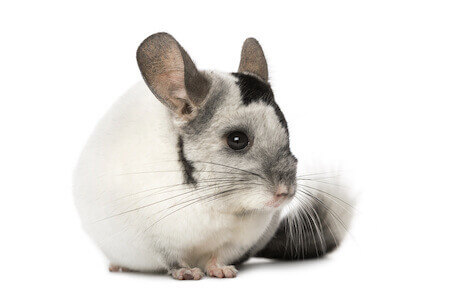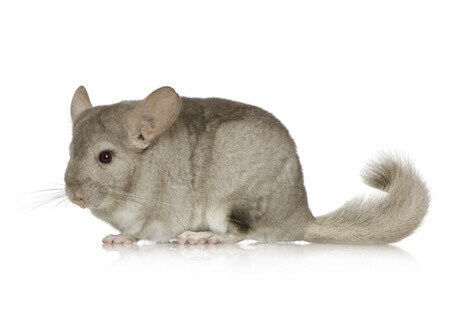Chinchilla Health: Preventing, Diagnosing and Treating Illness
Chinchillas are fairly hardy pets but they can develop some health concerns.
General Health Guidelines
Chinchillas typically have few health issues when they are properly cared for. One of the most important rules of caring for a chinchilla is diagnosing any problems as early as possible. The following are general care guidelines for preventing health issues in your chinchilla:
very sensitive to temperature
- Correct feeding. Chinchillas have sensitive digestive systems. They need a quality diet high in fiber and low in protein, fats, and sugar. Chinchillas do well with a variety of high quality pellets, hays, limited treats, and vitamin supplements.
- Avoid bedding made from undried pine or cedar as both have aromatic oils that can damage your chinchilla’s respiratory health.
- Proper environment. Chinchillas are very sensitive to temperature and require an ideal winter temperature between 55° – 65°F in the winter and no higher than 75°F in the summer. High temperatures and high humidity together can be fatal to a chinchilla. High temperature can also reduce the chinchilla’s resistance to infectious disease.
- Regular dust baths. Chinchillas require regular dust baths to maintain their coat and health, especially when humidity is high.
- Avoid stress and over-handling. Chinchillas do not do well when they are stressed, which can happen when they are handled too often or do not have an ideal environment. This can cause further health issues.
- Weigh your chinchilla regularly and keep a record of any noticeable behavioral changes to watch for signs of illness.
Parasites That Chinchillas Can Get
Chinchillas can be infected with several types of parasites, most notably giardia. Giardia is an opportunistic parasite that lies in wait in a healthy mammal like a chinchilla and waits until the animal becomes ill or stressed before multiplying and causing diarrhea, dehydration, constipation, and even death. It’s believed that all chinchillas carry this parasite in its dormant stage.
With giardia, the chinchilla may begin to cut back on the amount of food and water they take in with mild diarrhea during the early stage. After a few days, the chinchilla may no longer have hard, regular pellets before stopping all food intake and most water intake. By the end of the week, the chinchilla will appear listless and may have tremors and labored breathing.
Giardia infection must be treated quickly as it can soon prove fatal. Chinchillas with giardia are typically treated with fendendazole, albendazole, or metronidazole by a vet.
Overgrown Teeth and Dental Problems
Like other rodents, chinchillas can develop dental problems that need to be monitored and treated. Additionally, chinchillas, like other rodents, have open rooted teeth and they can grow up to 2-4 inches a year. A chinchilla’s teeth grow constantly throughout his life and he needs tough toys, fiber, and other objects to chew so his teeth don’t get too long. If the teeth get too long, they can catch on the flesh inside of the mouth and cause an injury. This is not a big problem if it’s caught early, but it can be fatal by preventing the chinchilla from eating.
Signs your chinchilla is developing maloccluded teeth include:
- Watery eyes
- Rubbing at the mouth
- Drooling
- Avoiding eating
Chinchillas with overgrown teeth can experience issues with eating and pain. Only a trained veterinarian can assist with this issue. Delaying treatment will just keep the chin in pain longer and make it harder to treat him/her.
Dental problems in chinchillas last the entire lifespan of the animal and often include crowning and treatment with antibiotics and anti-inflammatory medication. Owners can promote healthy teeth in their chins by feeding them a steady diet of hay and insuring that the chinchilla has regular access to a veterinarian with as much chinchilla experience as possible.
How to Diagnose and Treat Respiratory Diseases
Respiratory illnesses in chinchillas can become very serious quickly and should never be taken lightly. Symptoms in chinchillas that may relate to respiratory illness are fever, wheezing or other breathing problems, watery eyes, runny nose, lethargy, changes in mood, eating issues, and weight loss. Sometimes, a chinchilla’s environment will contribute to his/her poor health. Immediate fixes to help the chin will be to make sure that s/he is not living in overcrowded conditions, high humidity areas, or areas with too little ventilation around the cage.
If these fixes don’t alleviate the chinchilla’s issues immediately, it is best to take him/her to the veterinarian for a complete physical that may contain an x-ray. Finding a vet who has specialized in exotic pets may be more helpful as vets with less exposure to chinchillas may tend to over prescribe painkillers and antibiotics in attempt to ease symptoms without really digging in to the find the cause of the respiratory illness.
To assist in the chinchilla’s healing process, give his/her cage a deep cleaning before s/he returns from the vet. Disinfecting the cage after everything is removed is key to not spreading any existing disease. Also, lowering the humidity and protecting the chin from overcrowding is very important.
How to Spot Skin Fungus
Chinchillas have very soft, dense fur that can hide skin problems like a fungal infection. Make sure your chinchilla gets regular dust baths to avoid fungal infections. You can purchase dust for a chinchilla from a pet store, place it in a container, and allow the chinchilla to roll around in the dust about three times a week. Avoid an environment that is too humid to reduce the risk of skin fungus.
Ringworm
One of the most common skin fungi in chinchilla is ringworm—a common fungus to humans as well. If a chinchilla is in a high-humidity environment, s/he can develop ringworm. Ringworm is very hard to treat in chins, but once it is treated, the animal can return to a healthy state.
Symptoms of ringworm in chinchillas are scaly or dry skin, hairless areas on the body, circular markings or welts, shiny red skin, excessive itchiness, or signs of irritation. The main areas where ringworm will appear on chinchillas is nose, eyes, ears, and legs. The moment ringworm is suspected in a chinchilla, a vet visit is in order. Ringworm is very contagious and the infected chinchilla must be quarantined immediately. Also, a deep clean of the environment for the chinchilla is needed.
The veterinarian may administer an antibiotic through one of three means: topical, oral, or through a medicated dust bath. Whatever the method, the medication must be administered fully for the chinchilla to return to a ringworm-free state.
Dealing with Heat Stroke
Chinchillas naturally live in the Andes Mountains and they are most comfortable at temperatures between 35° – 45°F. Chinchillas can develop heat stroke in temperatures above 80°, especially if there is also high humidity, and this can easily be fatal. Signs of heat stroke in a chinchilla include:
- Panting
- High body temperature
- Open-mouth breathing
- Lethargy
Heat stress in chinchillas is a real issue and can be very scary for any chin lover. A chinchilla with heat stroke must be taken immediately to a cooler environment. Adding cool water to his/her water bottle and cool tiles to his/her cage are ways to help the chinchilla cool down. Fur covered frozen water bottles are naturally cooling centers for the chinchilla to cuddle with.
If these methods aren’t helping the chin, more drastic measures, like submerging the animal partially in cool (not cold or ice-filled) water. Comforting the animal while the submerging is going on is key to keeping him/her calm and not doing more damage. A 15-20 minute soak should be enough to cool the chin—making sure his/her head is above water the whole time. After the soak, dry the chinchilla with a towel thoroughly and get him/her to the veterinarian as soon as possible.
My Chinchilla has Diarrhea What Should I Do?
There are several reasons that a chinchilla may develop diarrhea. Narrowing down the cause is the first step to treating the symptom. The first question to ask is “what has changed in this chinchilla’s life recently?” Is s/he on a new medication or has the diet changed. Has his/her environment changed at all?
Stress, medication, and diet are the top causes of chinchilla diarrhea. If the chin has been put on a new medication, it is a good idea to touch base with the prescriber to see what remedies are recommended for intestinal distress. If the chinchilla has recently eaten something s/he shouldn’t have, a watch and wait remedy can normally be adopted. If it hasn’t been 24 hours, sometimes the offending material will work its way out. However, contacting the veterinarian is always a safe bet. If the chinchilla has recently switched to a more rich diet, like alfalfa, s/he could experience diarrhea during the transition period. That can be solved by switching back to the old diet or easing the chin in to the new diet.
Parasites, infection, and other diseases of the intestines also infect chins. These need to be diagnosed and treated through a veterinarian who has experience with chinchillas and how to treat their stomach issues. Once the chin has been prescribed the medication, the best course of action is administering the medication as prescribed and watching him/her carefully.
Other treatments at home are watching to make sure the chin’s food is free of mold or other contaminants, always providing clean water, and keeping the chinchilla in a clean and stress-free environment.
Eye Infections
Chinchillas are fairly prone to developing eye infections. If your chinchilla develops red, swollen eyes, it’s important to have a vet check them as soon as possible.
Why Is My Chinchilla Shedding So Much?
Chinchillas will shed normally every three months. This normally shedding lasts about two weeks and is completely normal and necessary for healthy chinchillas! They also shed a little bit every day, so having hair in their cage is commonplace.
Fur slip is a common fur disorder in chinchillas and happens when a chin is mishandled or stressed. Handling a chinchilla properly—by the base of the tail—is paramount in not inducing fur slip. A chinchilla must be tamed before handling in any situation. In addition to handling the animal correctly, having dust baths available for him/her to enjoy is very important to avoiding fur slip.
Chinchillas may lose hair for other reasons like alopecia and nursing mothers may lose hair due to the kits pulling on the hair during feeding.
Caring for a Sick Chinchilla
If your chinchilla is sick, he may hide the illness until it becomes more serious and harder to treat. Common symptoms that your chinchilla is sick include:
- Less or more consumption of food and water
- Drooling or a wet chest or chin
- Warm, red ears
- Agitated behavior
- Nasal discharge or wheezing
- Watery eyes
- Pawing at mouth
- Paying constant attention to a particular area of the body
A sick chinchilla should always be given a quiet, peaceful place in a dark, warm environment to recover. Stop giving treats and ensure your chinchilla has a steady supply of fresh water, hay, and pellets. You may want to add probiotics to your chinchilla’s diet. In some cases, dust baths may need to be suspended while your chinchilla recovers, especially in the case of an eye or respiratory infection.


